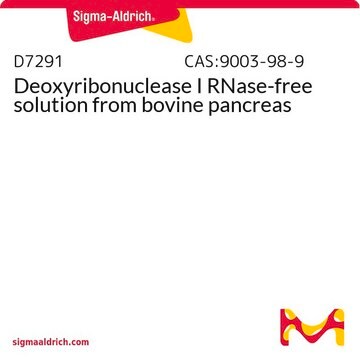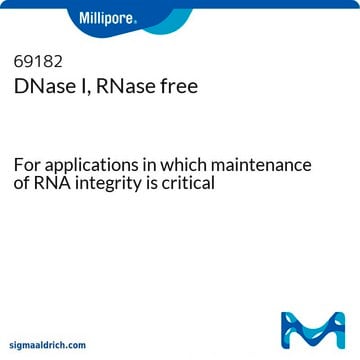As cited in the product listing and datasheet, this product in solution shows an approximate loss of activity of 10% when stored in aliquots at −20 °C for 1 week. Studies at lower dilutions have not been performed. Typically, solutions stored at higher concentrations are the most stable.
D5025
Deoxyribonuclease I from bovine pancreas
Type IV, lyophilized powder, ≥2,000 Kunitz units/mg protein
Synonym(s):
DNase I, Deoxyribonucleate 5′-oligonucleotido-hydrolase
About This Item
Recommended Products
biological source
bovine pancreas
Quality Level
type
Type IV
form
lyophilized powder
specific activity
≥2,000 Kunitz units/mg protein
mol wt
~31 kDa
purified by
chromatography
composition
Protein, ≥80%
technique(s)
DNA purification: suitable
solubility
0.15 M NaCl: soluble 5.0 mg/mL, clear, colorless
suitability
suitable for molecular biology
application(s)
diagnostic assay manufacturing
diagnostic assay manufacturing
foreign activity
Chymotrypsin ≤0.5%
Protease ≤0.05%
RNase ≤0.02%
shipped in
wet ice
storage temp.
−20°C
Looking for similar products? Visit Product Comparison Guide
Application
Biochem/physiol Actions
Unit Definition
Physical form
Preparation Note
Analysis Note
inhibitor
Signal Word
Danger
Hazard Statements
Precautionary Statements
Hazard Classifications
Resp. Sens. 1
Storage Class Code
11 - Combustible Solids
WGK
WGK 3
Flash Point(F)
Not applicable
Flash Point(C)
Not applicable
Choose from one of the most recent versions:
Certificates of Analysis (COA)
Don't see the Right Version?
If you require a particular version, you can look up a specific certificate by the Lot or Batch number.
Already Own This Product?
Find documentation for the products that you have recently purchased in the Document Library.
Customers Also Viewed
Protocols
To standardize a procedure for the enzymatic assay of Deoxyribonuclease I.
-
Good afternoon, if the stock concentration of 10mg/ml may loose 10% of its activity after one week, I was wondering if it is okey regarding stability to keep 500ug/ml aliquots at -20ºC for several weeks.
1 answer-
Helpful?
-
-
Is Kunitz unit same as unit here? I have seen some papers and they have U/ml for DNase. How can i conver it?
1 answer-
Product D5025, Deoxyribonuclease I is given in Kunitz units. This product is a powder. When reconstituting the product with a solution, for example 15,000 Kunitz units in 1 ml of 0.15 M NaCl the end-user will have 15,000 Kunitz units/ml.
Helpful?
-
-
What concentration of Product D5025, Deoxyribonuclease I (DNase I), is required to remove DNA from solutions?
1 answer-
DNA can be removed from preparations by incubation with 20 - 50 ug DNAse I in the presence of 50 mM Tris-HCl buffer, pH 7.5, 10 mM magnesium chloride, at 37°C. for 60 min.
Helpful?
-
-
What is the Department of Transportation shipping information for this product?
1 answer-
Transportation information can be found in Section 14 of the product's (M)SDS.To access the shipping information for this material, use the link on the product detail page for the product.
Helpful?
-
-
How should I prepare a solution of Product D5025, DNAse I?
1 answer-
This enzyme can be reconstituted in 0.15 M NaCl at a concentration of 10 mg/ml.
Helpful?
-
-
How do Deoxyribonuclease I (DNase I), products D5025 and D4527 differ from each other?
1 answer-
Both of these products have the same specific activity (>2000 units/mg protein) for Dnase I. The enzyme impurity levels for each, however, are different. D5025 has the following impurity specification: Chymotrypsin (<0.5%), Protease (<0.05%), and RNase (<0.02%). The impurity specifications for D4527 are: Chymotrypsin (<0.01%), Protease (<0.005%), and RNase (<0.01%).
Helpful?
-
-
Are stock solutions of Product D5025, Deoxyribonuclease I (DNase I), stable?
1 answer-
Solutions of DNAse I (10 mg/ml) in 0.15 M NaCl may lose 10% of its activity when stored for a week in aliquots at -20°C. The same solutions stored in aliquots at 2 - 8°C. lose approximately 20% activity.
Helpful?
-
-
How can I convert units of Product D5025, Deoxyribonuclease I (DNase I), to mass?
1 answer-
The mg of solid for each unit package size will be indicated on the label of the package. For a particular lot, you can calculate the specific activity in units per mg solid by multiplying the specific activity in units per mg protein by the percent protein divided by 100.
Helpful?
-
Active Filters
Our team of scientists has experience in all areas of research including Life Science, Material Science, Chemical Synthesis, Chromatography, Analytical and many others.
Contact Technical Service











